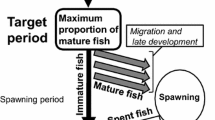Abstract
AdultActinopyga echinites (Jaeger) were collected from northern Taiwan in September 1989. Oocytes were induced to mature by bathing them in ovary juice (ovary-induced ova) or in 10−2 M dithiothreitol (DTT-induced ova). The percentage of germinal vesicle breakdown (GVBD) increased from 0.4 to 6.4% in the former treatment and to 84% in the latter. After artificial fertilization, the embryos were cultured in seawater (35‰ S) at 25 to 28°C. Larvae were fed with the algaIsochysis aff.galbana at 104–5 cells/ml. Larvae from ovary-induced ova developed faster (18 d to the doliolaria stage) and grew to a larger size (1.13 mm length) than those from DTT-induced ova (20 d to the doliolaria stage and 0.62 mm in length). On the twelfth day, larvae from ovary-induced ova bear lipid spheres. The number of spheres is positively correlated with larval size. Lipid spheres may provide nutrient reserves for larvae during metamorphosis.
Similar content being viewed by others

Literature cited
Chen, C.-P., Chian, H.-S. (1990). Larval development of the sea cucumber,Actinopyga echinites (Echinodermata: Holothuroidea). Bull. Inst. Zool., Acad. sin. 29: 127–133
Clark, A. M., Rowe, F. W. E. (1971). Monograph of shallow-water Indo-west Pacific echinoderms. Publs Trustees Br. Mus. (nat. Hist.) 690: 1–238
Cleland, W. W. (1964). Dithiothreitol, a new protective reagent for SH groups. Biochemistry, Easton, Pa. 3: 480–482
Conand, C. (1982). Reproductive cycle and biometric relations in a population ofActinopyga echinites (Echinodermata: Holothuroidea) from the lagoon of New Caledonia, Western tropical Pacific. In: Lawrence, J. M. (ed.) Proceedings of the International Conference on Echinoderms, Tampa Bay. A. A. Balkema, Rotterdam, p. 437–443
Drozdov, A. L., Kornienko, E. S., Kruchkova, G. A. (1991). The early embryonal development and metamorphosis in the far eastern sea cucumber (Stichopus japonicus). In: Yanagisawa, T. et al. (eds.) Proceedings of the Seventh International Echinoderm Conference, September 9–14 1990, Atami, Japan. A. A. Balkema, Rotterdam, (in press)
Ikeda, Z., Kusaka, K., Ueki, N. (1989). Effective rearing method of settled juveniles of sea cucumberStichopus japonicus. Okayama Sui Sain Si Kein Ho KoRu 4: 56–63 [in Japanese; Rep. Fish. exp. Stn, Okayama]
Ishida, M. (1979). Studies on seed production of sea cucumberStichopus japonicus. Saibai-gyugyu Giztsu kaihatsu kenkou 8: 63–75 [in Japanese, English abstract]
Hufty, H. M., Schroeder, P. C. (1974). A hormonally active substance produced by the ovary of the holothurianParastichopus californicus. Gen. comp. Endocr. 23: 348–351
Humason, G. L. (1979). Animal tissue techniques. 4th ed. W. H. Freeman & Co., San Francisco
Hyman, L. H. (1955). The invertebrates: Echinodermata. Vol. IV. McGraw-Hill Book Co., New York
Kanatani, H., Hiramoto, Y. (1970). Site of action of 1-methyladenine in inducing oocyte maturation in starfish. Expl Cell Res. 61: 280–284
Kanatani, H., Shirai, H., Nakanishi, K., Kurokawa, T. (1969). Isolation and identification of meiosis inducing substance in starfish,Asterias amurensis. Nature, Lond. 221: 273–274
Kishimoto, T., Cayer, M. L., Kanatani, H. (1976). Starfish oocyte maturation and reduction of disulfide-bond on oocyte surface. Expl Cell Res. 101: 104–110
Kishimoto, T., Kanatani, H. (1973). Induction of starfish oocyte maturation by disulfide-reducing agents. Expl Cell Res. 82: 296–302
Maruyama, Y. K. (1980). Artificial induction of oocyte maturation and development in the sea cucumbersHolothuria leucospilota andHolothuria pardalis. Biol. Bull. mar. biol. Lab., Woods Hole 158: 339–348
Maruyama, Y. K. (1985). Holothurian oocyte maturation induced by radial nerves. Biol. Bull. mar. biol. Lab., Woods Hole 168: 249–262
Maruyama, Y. K. (1986). Induction of sea cucumber oocyte maturation by starfish radial nerve extract. J. exp. Zool. 238: 241–248
McEuen, F. S. (1987). Chapter 28. Phylum Echinodermata, class Holothuroidea. In: Strathmann, M. (ed.) Reproduction and development of marine invertebrates of the Northern Pacific coast. University of Washington Press, Seattle, p. 574–596
McEuen, F. S. (1988). Spawning behaviors of northeast Pacific sea cucumbers (Holothuroidea: Echinodermata). Mar. Biol. 98: 565–585
Mortensen, Th. (1938). Contributions to the study of the development and larval forms of echinoderms. IV. K. danske Vidensk. Selsk. Skr. (Naturvidensk. Math. Afd.) 7(3): 1–59, 12 pls
Shirai, H. (1986). Gonad-stimulating and maturation-inducing substance. Meth. Cell Biol. 27: 73–88
Smiley, S. (1986). Metamorphosis ofStichopus californicus (Echinodermata: Holothuroidea) and its phylogenetic implications. Biol. Bull. mar. biol. Lab., Woods Hole 171: 611–631
Smiley, S. (1988). Investigation into purification and identification of the oocyte maturation hormone ofStichopus californicus (Holothuroidea: Echinodermata). In: Burke, R. D., Mladenov, P. V., Lambert, P., Parsley, R. L. (eds.) Echinoderm biology. A. A. Balkema, Rotterdam, p. 541–549
Strathmann, R. R., Satoh, H. (1969). Increased germinal vesicle breakdown in oocytes of the sea cucumberParastichopus californicus induced by starfish radial nerve extract. Expl Cell Res. 54: 127–129
Sui, X. (1989). The main factors influencing the larval development and survival rate of the sea cucumber. Oceanologia Limnol. sin. 20: 314–321 [in Chinese, English abstract]
Sui, X., Hu, Q., Chen, Y. (1986). A study on technology for rearing of postlarvae and juveniles of sea-cucumber in high density tanks. Oceanologia Limnol. sin. 17: 513–520 [in Chinese, English abstract]
Author information
Authors and Affiliations
Additional information
Communicated by M.G. Hadfield, Honolulu
Rights and permissions
About this article
Cite this article
Chen, C.P., Hsu, H.W. & Deng, D.C. Comparison of larval development and growth of the sea cucumberActinopyga echinites: Ovary-induced ova and DTT-induced ova. Mar. Biol. 109, 453–457 (1991). https://doi.org/10.1007/BF01313510
Accepted:
Issue Date:
DOI: https://doi.org/10.1007/BF01313510



